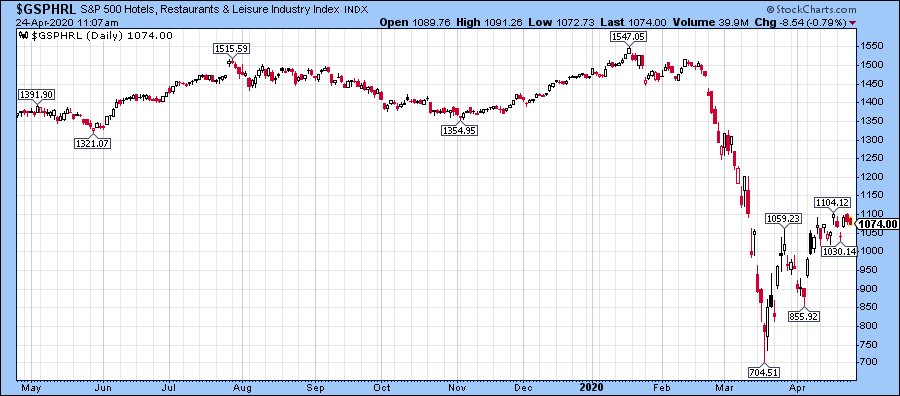Stocks surged following the March 23 Coronavirus crash low.
And it’s the same old theme – large cap tech growth firms have pretty much led the way.
The handful of largest companies make up about a quarter of the S&P 500’s total market cap, the highest percentage in decades. Many investors now ask (angrily, if I may say), “GDP may contract 30% this quarter and unemployment could hit 20%. How can stocks be just 15% off the high? How can the NASDAQ 100 be nearly up for the year?”
Let’s dive a bit deeper.
Sure, the biggest tech companies have weathered the storm relatively well so far. Those firms have significant cash on their balance sheets and, in a way, can benefit from the move toward more virtual working and less physical travel.
But what about the industries that would be most affected by folks staying at home and pinching their pennies?
And let’s not forget the devastation in the oil space. I digress…
Over the last year, movie theater stocks are down 80%. Oil & gas service names slid 70%. Airlines took a 60% tailspin. Retail REITs retreated 55%. Resorts & casinos contracted 50%.
Here’s a snapshot of the Hotels, Restaurants & Leisure Stocks Index:

Interestingly though, restaurants are only 20% lower year-on-year. How can that be?
The take-out & delivery push has seemingly worked well for some of the biggest market cap restaurants like McDonald’s, Wendy’s, Yum China, Chipotle & Domino’s. Together, those names are positive from this time a year ago and have massive gains from the March low. Restaurants focused on dine-in have not fared well – that group is down 50-60% since mid-February.
On a style-basis, small cap value is where many of the hammered-down names are buried. Hopefully they will be resurrected before long.
Retail names like Macy’s, BJ’s Restaurants, Denny’s, Bloomin Brands, JC Penney are small cap value. So too are energy companies such as Southwestern, Noble and Range Resources. You will also find a slew of REITs in this beaten style. Together, small cap value is down about 33% over the last 52 weeks. Large cap growth is up 7% for perspective. The S&P 500 is 3% lower.
Small cap value actually peaked in August 2018. It is now a whopping 35% below that high.
Let’s have some fun with the numbers. The iShares S&P Small-Cap 600 Value ETF (IJS) peaked at $174.26. If it returns 8% per year from today (assuming a 2.5% dividend yield), it will finally notch a new all-time high in 10 years – Q2 2030. That would mean nearly 12 years of ‘dead money’ – much of that due to the Corona-crash.
Hopefully that puts in perspective the extent of recent declines across some of the hardest hit areas of the stock market, mostly as a result of the last 2-3 months.
I am a Chartered Financial Analyst (CFA) and Chartered Market Technician (CMT). I have passed the coursework for the Certified Financial Planner (CFP) program. I look to leverage my skills in a consultant role for financial advisors – that could be portfolio analysis, planning, writing etc. Please reach out to me at mikeczaccardi@gmail.com for more information. Connect on Linkedin.
Twitter: @MikeZaccardi
The author may hold positions in mentioned securities. Any opinions expressed herein are solely those of the author, and do not in any way represent the views or opinions of any other person or entity.








